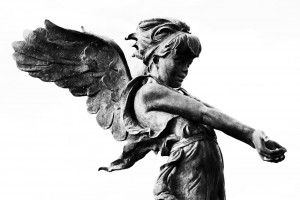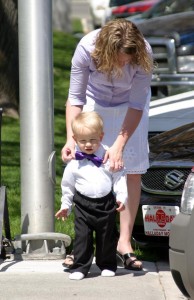Each anniversary of the fall of the Berlin Wall is a bit embarrassing for me.
Year: 2009
The Road
“Fathers do not mother”
Kaimi put up a sidebar link to a NYT piece on parenting. It had an interesting quote: “Fathers tend to do things differently, Dr. Kyle Pruett said, but not in ways that are worse for the children. Fathers do not mother, they father.”
Under Intellectual Condemnation
Let me begin by saying that I not only believe in the historicity of The Book of Mormon, I feel a deep and passionate commitment to our narrative. But this is a point on which I think Mormon historicitists, believers in a divine or human fiction, or any other type of good Mormon ought to be able to agree: The Book of Mormon is rich far beyond our nascent attempts to uncover.
Let not thy left hand know that thy light so shines before men
For over a year I’ve wanted to write a substantive post about the contradiction between two of the best-known biblical injunctions, “let not thy left hand know what thy right hand doeth” and “let your light so shine before men that they may see your good works.”
From the Archives: The Reynolds Jury Charge
The trial court in Reynolds v. United States gave the following jury charge, which the Supreme Court later found was proper and not inflammatory. I think it not improper, in the discharge of your duties in this case, that you should consider what are to be the consequences to the innocent victims of this delusion.
A Mormon Image: Guardian Angel

This is a statue of an angel in the cemetery where my first baby is burried. I like that she’s smiling. Death is heartbreaking but it’s not only sad. I am also filled with hope when I think about my son. He is alive and happy and we can be an eternal family. It has always been such a comfort to know that.
Kirsten Obert
Springville, UT
What Happened in Nauvoo, Part 2: Flourishing
[See Part 1: Founding] This second installment discussing Glen Leonard’s Nauvoo: A Place of Peace, a People of Promise looks at the middle years in Nauvoo through about 1842, covered in the second section of the book (pages 123 to 269).
True Adventures in Turning the Other Cheek, Pt. Two
For the next several weeks, I attended church when I could. Participation often included lowering my eyes when the bishop or his first counselor walked by and gave me stern “We’re watching you” stares. In some ways the whole business interested me so I wasn’t suffering as much as some might suppose. But given the treatment of these two ward leaders, I did feel somewhat cordoned off. Perhaps that’s why when a prettily decorated invitation to a special R.S. council arrived in my mailbox, in a fit of high irritation, I nearly tossed it.
True Adventures in Turning the Other Cheek, Pt. One
Preface. At the risk of running afoul of Nate’s post on turning the other cheek—that is, of appearing obnoxiously immodest and of proving myself once again impossibly dense—I’m telling a story about how I received one of the best lessons I’m still learning. It’s a long story and hopelessly self-referential. Over the last two decades, I’ve slowly awakened to my unfortunate condition: I don’t have access to the details of anybody else’s mistakes or near-mistakes as fully as I do to my own, so those stories where I made matters worse (or nearly did) and those which, surprisingly, erupted into fireworks at the end are the ones I have the greatest right to tell. Of course, no adventure unfolds in a social vacuum. It’s unavoidable that others should be mentioned, and—darn it—their actions described from my point of view. I apologize in advance for this story’s unlikelihood. I don’t expect anybody to believe it. If you’ve already lost patience over other unlikely stories I’ve told, turn back now. Also, some sensitive readers might find this story frightening. Its characters and events include a severely disabled child (my daughter), the zombie virus that destroyed part of her tender mind, a very unhappy bishop and his deputy first counselor, and people tendering advice that some readers might find bothersome. If you’re having a bad day, you’d be better off reading something else. On July 24, 1992, one or more arsonists attempted to…
A Mormon Image: House of Learning
The very thought is sweet
Leftover Halloween candy languishes in its plastic pumpkin on top of the refrigerator; for the moment, the kids are satiated and I’m being good. All the sugar brings to mind a favorite hymn, “Jesus, the very thought of thee,” a few stanzas of which are here: Jesus, the very thought of Thee With sweetness fills the breast; But sweeter far Thy face to see, And in Thy presence rest.
A Mormon Image: Baptism
Day of the Dead, Lord of Life
cross posted at Civil Religion “Death be not proud,” taunted John Donne. “One short sleepe past, wee wake eternally, / And death shall be no more; death, thou shalt die.” Death interrupts our view of eternity, a fearsome jalousie obscuring a future we must approach. Like Donne, we console and distract ourselves by turns with bravado, with pleasure, with laughter and—finally, always—with God.
St Louis Mormon Historical Society meets Friday
Trivia fact for the day: the Mormon church operated a newspaper, the St. Louis Luminary, from November 1854 to December 1855. The periodical served the large community of transient Latter-day Saints, many of whom stopped in St Louis to replenish their strength (and funds) after the first leg of their journey to the Salt Lake Valley. In 1855, the paper commented, “There is probably no city in the world where Latter-day Saints are more respected, and where they may sooner obtain an outfit for Utah. … The hand of the Lord is in these things.” If you’re intrigued, and you live in the St Louis area, you can learn more about the early history of Mormons in St Louis at the first meeting of the St Louis Mormon Historical Society. The event will take place tomorrow night, Friday, October 30, at 7:00 pm at The Lodge Des Peres. It promises to be an interesting evening, and I’m hoping to attend myself.
The Zeal of a Convert
There’s an interesting new study from Pew about converts.
Same-sex Marriage and Change
Will same-sex marriage change the institution of marriage? Melissa Harris-Lacewell writes in The Nation that maybe, hopefully, it will.
The Dispensation of the Fulness of Times®
So the upcoming RS/MP lesson got me thinking: What exactly does the phrase “the dispensation of the fulness of times” actually mean?
The Nasty Side of Christian Ethics
The language of turning the other cheek and Christian ethics in general can really get quite nasty.
Halloween Costumes and Inner Conflict
Halloween scares me. Of course, I’m scared of lots of things—poverty, cancer, rape, gang violence, Satan, etc. I thought I should admit that up front. Make of it what you will.
President Monson wins the prize

So Slate keeps track of who it considers the most powerful octogenarians and President Monson tops the list. If ever there was a list where Mormons could shine that did not have to do with singing and dancing I guess it makes sense that it would be “powerful old men”. To loosely paraphrase President Hinckley, isn’t it wonderful to have somebody in there with decades of experience who is not moved about by every wind of doctrine?
Human life, religious voices and the public square
Cross-posted at Civil Religion. Last week the New York Times published a two–part series on artificial reproductive technologies. The series makes a riveting read, as writer Stephanie Saul narrates the joys and terrors of premature birth, high order multiples, NICU stays, and—finally, sometimes—the precious goal, a baby at home with a family.
A Mormon Image: Preparing for the Wedding Reception

Photo by L-s Sus, who writes:
The picture is of my wife and son and was taken at my sister’s wedding. It captures many themes that resonate with my concept of Mormon identity: Family, Motherhood, Nurturing, and Beauty. It also reminds me that we have benevolent heavenly parents who reach down and give assistance, and that we are just children in the grand scheme of things.
Photo Series: A Mormon Image

In an effort to increase the beauty-to-blather ratio around here, we’d like to kick off a new series of posts featuring photos and other images which carry meaning to us because they resonate with our Mormonness. And we’d like to include all of you in this project. That is, we’re inviting you all to send in submissions for the new T&S series, A Mormon Image.
MR: “Music From Across the Divide”
A new issue of The Mormon Review is available, with a review of the music of Sara Groves by Troy Keller. The article is available at: Troy Keller, “Music From Across the Divide,” The Mormon Review, vol.1 no. 7 [HTML] [PDF] For more information about MR, please take a look at the prospectus by our editor-in-chief Richard Bushman (“Out of the Best Books: Introducing The Mormon Review,” The Mormon Review, vol.1 no.1 [HTML][PDF]). In addition to our website, you can have The Mormon Review delivered to your inbox. Finally, please consider submitting an article to MR.
Gays and the Church: Whose Ox is Being Gored?
When people talk about Prop 8 or gay-Mormon relations generally, a common theme is that a smaller, less powerful group is the victim of an unfair attack from a larger and more powerful aggressor. This theme is used repeatedly on both sides of the debate. It was a central theme in Elder Oaks’ recent talk about religious liberty. And it was immediately raised in criticisms of that talk, with church critic Fred Karger telling the Associated Press, “They are trying to be the victim here. They’re not. They’re the perpetrators.” It’s clear that this basic framing is employed by both sides in the argument. This raises the question — who is the bully here? Whose ox is being gored? Interestingly *both* the LDS and gay communities have plausible evidence to support the claims that they are the victim group.
Are the Books Available?
It is a bit of a coincidence that, as I prepared my regular list of the books and other media mentioned in General Conference, one of the LDS discussion forums in Brazil I follow was lamenting the decision to discontinue selling classic LDS works in Portuguese, like Talmage’s The Articles of Faith and LeGrand Richard’s A Marvelous Work and a Wonder.
The Doctrine of Revelatory Justiciability
A good friend, while studying constitutional law for the bar exam this summer, emailed me some thoughts he scribbled down when he should have been hacking away at a few more MBE questions on judicial review. Instead, however, he hammered out a constitutional analysis on the justiciability of prayers. You see, in case you weren’t aware, in order to receive an answer to a prayer, one’s prayer must involve a “case or controversy” that is fit for review. So, without further adieu, allow me to present the doctrine of revelatory justiciability (a.k.a., what studying for the bar does to your brain).
Peace Prize Shock
At first I thought it might be a joke of some kind. I waited for a “just kidding” qualification from the radio news announcer. Then the news item finished. The Nobel Peace Prize was awarded to Barack Obama.
Holland and the gap, again
Leaving aside disagreements about Elder Holland’s tone and speculations about the talk’s effect on believers and skeptics—not that those are unimportant, but that they’re being vigorously played out elsewhere—I want to make a narrow point about the philosophical underpinnings* of his talk.







